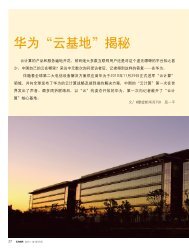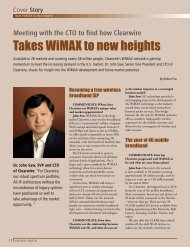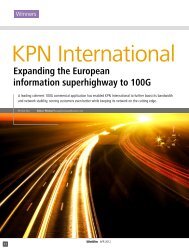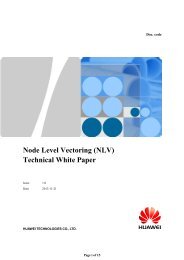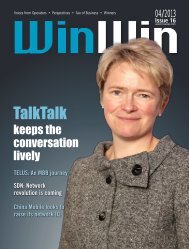Download - Huawei
Download - Huawei
Download - Huawei
You also want an ePaper? Increase the reach of your titles
YUMPU automatically turns print PDFs into web optimized ePapers that Google loves.
30<br />
33<br />
36<br />
39<br />
Building an efficient<br />
100G transmission network<br />
Taking the correct “route”<br />
DPoE boosts enterprise access<br />
MSO evolution through small-cell networking<br />
Building an efficient<br />
100G transmission network<br />
By Fang Guangxiang<br />
Trends and challenges<br />
for 100G transmission<br />
W<br />
ith surging bandwidth<br />
demands on the<br />
Internet backbone<br />
and a rapid growth<br />
of related services such as IPTV, VoD,<br />
and 3G applications, network operators<br />
and Internet service providers (ISPs) are<br />
looking for efficient high-bandwidth<br />
transport solutions, such as the 100GE<br />
interface and DWDM, which should<br />
provide greater bandwidth at a lower<br />
cost per bit. Currently, 40G WDM<br />
transmission systems are widely<br />
deployed, yet some backbone networks<br />
are expected to have bandwidth<br />
shortages by 2012; 100G would seem<br />
the next step forward.<br />
During the progression from 2.5 to<br />
10Gbps, and later from 10 to 40Gbps,<br />
WDM transmission technologies faced<br />
physical limitations such as a higher<br />
optical signal-to-noise ratio (OSNR),<br />
lower dispersion tolerance, lower<br />
polarization mode dispersion (PMD)<br />
tolerance, and intensified nonlinear<br />
fiber effects. These physical limitations<br />
relate to data rate and transmission<br />
distance, and will further compromise<br />
transmission performance when line<br />
rates increase from 40 to 100Gbps.<br />
Key 100G technologies<br />
To address technical challenges and<br />
meet 100G transmission requirements,<br />
the telecom industry generally reduces<br />
the optical spectral width to improve<br />
the bit rate per spectrum width.<br />
Other measures include modulation<br />
formatting, which lowers the required<br />
optical signal-to-noise ratio (ROSNR),<br />
as well as better system resistance to<br />
transmission impairments. Another<br />
solution is to use digital signal<br />
processing (DSP) technology to reduce<br />
the chromatic dispersion and PMD<br />
effects of optical fiber.<br />
However, we need to consider cotransmission<br />
of 100G with other<br />
data rates, such as 40G and 10G<br />
wavelength; it is impossible for singlelevel<br />
modulation to meet 100G and<br />
50GHz channel spacing requirements<br />
at the same time. Instead, the system<br />
must employ advanced multiplexing<br />
technologies so that an optical channel<br />
contains multiple binary channels. This<br />
reduces the baud rate while keeping the<br />
line bitrate unchanged; it also ensures<br />
that the spectral width is smaller than<br />
50GHz, even after the line rate is<br />
increased to 100Gbps. A number of key<br />
technologies have been developed to<br />
meet these requirements.<br />
QPSK modulation<br />
As a multi-level modulation format,<br />
quadrature phase shift keying (QPSK)<br />
decreases the baud rate of optical signals<br />
by half while keeping the line rate<br />
NOV 2011 . ISSUE 62<br />
30



